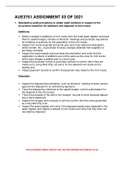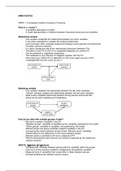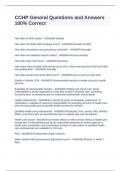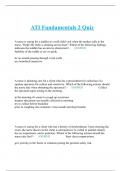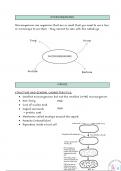Psychobiology
Psychobiology in a historical perspective – Peter Meerlo
Psychobiology is about biological mechanisms underlying behaviour, cognition and emotion.
Brain mechanisms, peripheral nervous system, hormones and immune system are all connected and
interacting with each other.
The brain does not only regulate and drive peripheral processes, but the peripheral processes can in
turn have effects on brain systems and functional output of the brain.
Example:
The response to a stressful event is associated with a potential danger (e.g. snake) involves
activation of brain mechanisms and that drives emotional and behavioural responses activation of
peripheral mechanisms necessary to support this response.
Strong of the hormones released during stress have a strong influence on the brain which allows you
to build up experience.
Are mind and body separate? Or are they the same? And if they are the same: is the mind and the
spirit a part of the body or is the body a part of the mind? dualism vs. monism
Dualism: body and the mind are different entities.
Monism: body and the mind are the same.
Aristotle: “It is not necessary to ask whether the soul and body are one, just as it is not necessary to
ask whether the wax and its shape are one”.
Without the body, there cannot be a mind.
Hippocrates played an important role in humorism: temperament and mental health depend on the
balance between four distinct bodily fluids or “humors”.
blood, yellow bile, black bile, phlegm
Associated with
Organs: the liver, the spleen, the gallbladder and lungs.
Physical qualities: cold, hot, wet and dry.
The four elements: air, earth, fire and water.
Somebody’s mental state and temperament are the result of complex interactions between the
bodily fluids and all these other elements.
Galenus performed experiments on animals that were alive. During one of his experiments on a pig
he accidently cut through the nerve connected to the larynx pig became quiet.
He demonstrated that the brain regulates behaviour.
Psychobiology as a scientific discipline took off in the 19 th century.
William James wrote ‘The principles of psychology’ with a biological view.
Together with Carl Lange he developed the James-Lange theory of emotion: emotions arise from
physiological responses to stimuli.
1
,Knight Dunlap is the writer of the book “An outline of Psychobiology” and eitor of the scientific
journal “Psychobiology” on the interconnection of mental and physiological functions.
Cesare Lombroso
Antropological criminology
Relationship between certain physical characteristics of the skull and jaw (sloping foreheads, jutting
chins) and criminal behavior Homo delinquens
This idea could not be confirmed by real data.
Jose Manuel Rodriguez Delgado
Controlling behavior by electrical stimulation of specific brain regions.
He implanted electrodes in animal brains and showed that certain stimuli could either trigger or
inhibit certain behaviours.
inhibiting aggression in a bull: he could stop the bull from attacking when pushing the button for
electrical stimuli.
Modern psychobiology research
How do we advance our knowledge of behavioral neuroscience?
Observations, measurements
Experimental manipulation
Methods and research strategies – Peter Meerlo
Techniques that are used to see wat happens in the brain
In vivo recording of neuronal activity:
Measuring the electrical activity of single cells or groups of neurons by means of electrodes
Global cortical activity with macroelectrodes (electroencephalogram) on skin
Single cell or multi-unit activity with microelectrodes inserted into the brain
Stereotactic surgery for precise location of electrodes, generally done in animals.
Brain atlas to look up the coordinates of the target region relative to the visible sutures of the skull.
Anesthetize animal and place it in the stereotactic apparatus.
In vivo assessment of brain biochemistry by means of microdialysis
Determine the concentration of small molecules in the extracellular fluid that surround neurons. In
many cases these molecules are released by neurons (e.g. neurotransmitters).
These specific molecules are sampled by means of a semipermeable dialysis membrane. Stereotactic
surgery for precise location of microdialysis probe.
Place a probe or tube with a very small semipermeable membrane at the end at the exact location in
the brain. The molecules that flow around get into the tube. Whenever you want you can make a
sample of the fluid and analyze it.
Very complex technique and it only allows analysis of molecules that are released by the cells, cannot
measure structural molecules of neurons or molecules that are only present inside the cell (e.g.
mRNA).
Another limitation: cannot put too many tubes in the brain at the same time no simultaneous
measurements at another location in the brain.
Collection of brain material for biochemical analysis
Measurement of mRNA or protein concentrations in homogenates of brain tissue.
This method includes measurement of structural molecules or molecules that are inside cells.
2
, Collecting brain material
Homogenization of brain material (whole brains of dissected regions)
Specific analysis procedures
o Biochemical assays
o Polymerase Chain Reaction (PCR)
o Western blotting procedures
^ Blotting method: separating proteins on the basis of their size (or charge) determines how rapidly
these proteins run through a gel. On the blotting membrane specific antibodies are bound to make
the protein you are interested in visible. The bands tell you if the molecule indeed is part of the
sample and the optical density shows how much of this molecule was in the sample.
quick and easy method, does not require surgery. Disadvantage: cannot do repeated
measurements, it is a snapshot of the brain at a specific single moment in time making the
interpretation of results difficult.
Collection of brain material for staining procedures
Immunohistochemistry
Staining of brain sections with an antibody or ligand that binds
Collection (and fixation) of brain material
Sectioning of brains with a microtome
Incubation of sections with specific antibodies or ligands
Microscopic analysis
Cut brain in very thin sample on which antibodies are applied. These antibodies bind to coloring
substance which shows where in the brain size the protein is located (microscope).
Advantage: can access the location of certain proteins throughout the brain with a high spatial
resolution.
Disadvantage: poor temporal resolution, cannot do this method repeatedly over a longer period of
time.
3
, The new frontier in immunohistochemistry: “clarity”
Transformation of intact brain tissue into a hydrogel-hybridized form:
Making the brain tissue completely transparent by replacing all the cell membrane lipids with
hydrophilic polymers while keeping brain structure intact.
Same immunohistochemistry staining with antibody and colored product, but with intact brain tissue
instead of a thin brain slice can do the microscopy of big parts of the brain or even the whole
brain.
Advantage: see the connection between different brain regions.
Each method and technique has its pro’s and con’s and there is no single one that tells it all.
Differences in the nature of read outs
Differences in temporal resolution
Differences in spatial resolution
Often need multiple approaches at the same time in order to draw conclusions.
See what happens in the human brain
Post mortum: biochemical analysis or staining of brain material
Restriction: no control over how and when people die. Also, there is tremendous variation in the
brain of humans.
In vivo:
Electrophysiological recordings from the scalp (EEG)
Magnetic resonance imaging (MRI)
Positron emission Tomography (PET)
4
Psychobiology in a historical perspective – Peter Meerlo
Psychobiology is about biological mechanisms underlying behaviour, cognition and emotion.
Brain mechanisms, peripheral nervous system, hormones and immune system are all connected and
interacting with each other.
The brain does not only regulate and drive peripheral processes, but the peripheral processes can in
turn have effects on brain systems and functional output of the brain.
Example:
The response to a stressful event is associated with a potential danger (e.g. snake) involves
activation of brain mechanisms and that drives emotional and behavioural responses activation of
peripheral mechanisms necessary to support this response.
Strong of the hormones released during stress have a strong influence on the brain which allows you
to build up experience.
Are mind and body separate? Or are they the same? And if they are the same: is the mind and the
spirit a part of the body or is the body a part of the mind? dualism vs. monism
Dualism: body and the mind are different entities.
Monism: body and the mind are the same.
Aristotle: “It is not necessary to ask whether the soul and body are one, just as it is not necessary to
ask whether the wax and its shape are one”.
Without the body, there cannot be a mind.
Hippocrates played an important role in humorism: temperament and mental health depend on the
balance between four distinct bodily fluids or “humors”.
blood, yellow bile, black bile, phlegm
Associated with
Organs: the liver, the spleen, the gallbladder and lungs.
Physical qualities: cold, hot, wet and dry.
The four elements: air, earth, fire and water.
Somebody’s mental state and temperament are the result of complex interactions between the
bodily fluids and all these other elements.
Galenus performed experiments on animals that were alive. During one of his experiments on a pig
he accidently cut through the nerve connected to the larynx pig became quiet.
He demonstrated that the brain regulates behaviour.
Psychobiology as a scientific discipline took off in the 19 th century.
William James wrote ‘The principles of psychology’ with a biological view.
Together with Carl Lange he developed the James-Lange theory of emotion: emotions arise from
physiological responses to stimuli.
1
,Knight Dunlap is the writer of the book “An outline of Psychobiology” and eitor of the scientific
journal “Psychobiology” on the interconnection of mental and physiological functions.
Cesare Lombroso
Antropological criminology
Relationship between certain physical characteristics of the skull and jaw (sloping foreheads, jutting
chins) and criminal behavior Homo delinquens
This idea could not be confirmed by real data.
Jose Manuel Rodriguez Delgado
Controlling behavior by electrical stimulation of specific brain regions.
He implanted electrodes in animal brains and showed that certain stimuli could either trigger or
inhibit certain behaviours.
inhibiting aggression in a bull: he could stop the bull from attacking when pushing the button for
electrical stimuli.
Modern psychobiology research
How do we advance our knowledge of behavioral neuroscience?
Observations, measurements
Experimental manipulation
Methods and research strategies – Peter Meerlo
Techniques that are used to see wat happens in the brain
In vivo recording of neuronal activity:
Measuring the electrical activity of single cells or groups of neurons by means of electrodes
Global cortical activity with macroelectrodes (electroencephalogram) on skin
Single cell or multi-unit activity with microelectrodes inserted into the brain
Stereotactic surgery for precise location of electrodes, generally done in animals.
Brain atlas to look up the coordinates of the target region relative to the visible sutures of the skull.
Anesthetize animal and place it in the stereotactic apparatus.
In vivo assessment of brain biochemistry by means of microdialysis
Determine the concentration of small molecules in the extracellular fluid that surround neurons. In
many cases these molecules are released by neurons (e.g. neurotransmitters).
These specific molecules are sampled by means of a semipermeable dialysis membrane. Stereotactic
surgery for precise location of microdialysis probe.
Place a probe or tube with a very small semipermeable membrane at the end at the exact location in
the brain. The molecules that flow around get into the tube. Whenever you want you can make a
sample of the fluid and analyze it.
Very complex technique and it only allows analysis of molecules that are released by the cells, cannot
measure structural molecules of neurons or molecules that are only present inside the cell (e.g.
mRNA).
Another limitation: cannot put too many tubes in the brain at the same time no simultaneous
measurements at another location in the brain.
Collection of brain material for biochemical analysis
Measurement of mRNA or protein concentrations in homogenates of brain tissue.
This method includes measurement of structural molecules or molecules that are inside cells.
2
, Collecting brain material
Homogenization of brain material (whole brains of dissected regions)
Specific analysis procedures
o Biochemical assays
o Polymerase Chain Reaction (PCR)
o Western blotting procedures
^ Blotting method: separating proteins on the basis of their size (or charge) determines how rapidly
these proteins run through a gel. On the blotting membrane specific antibodies are bound to make
the protein you are interested in visible. The bands tell you if the molecule indeed is part of the
sample and the optical density shows how much of this molecule was in the sample.
quick and easy method, does not require surgery. Disadvantage: cannot do repeated
measurements, it is a snapshot of the brain at a specific single moment in time making the
interpretation of results difficult.
Collection of brain material for staining procedures
Immunohistochemistry
Staining of brain sections with an antibody or ligand that binds
Collection (and fixation) of brain material
Sectioning of brains with a microtome
Incubation of sections with specific antibodies or ligands
Microscopic analysis
Cut brain in very thin sample on which antibodies are applied. These antibodies bind to coloring
substance which shows where in the brain size the protein is located (microscope).
Advantage: can access the location of certain proteins throughout the brain with a high spatial
resolution.
Disadvantage: poor temporal resolution, cannot do this method repeatedly over a longer period of
time.
3
, The new frontier in immunohistochemistry: “clarity”
Transformation of intact brain tissue into a hydrogel-hybridized form:
Making the brain tissue completely transparent by replacing all the cell membrane lipids with
hydrophilic polymers while keeping brain structure intact.
Same immunohistochemistry staining with antibody and colored product, but with intact brain tissue
instead of a thin brain slice can do the microscopy of big parts of the brain or even the whole
brain.
Advantage: see the connection between different brain regions.
Each method and technique has its pro’s and con’s and there is no single one that tells it all.
Differences in the nature of read outs
Differences in temporal resolution
Differences in spatial resolution
Often need multiple approaches at the same time in order to draw conclusions.
See what happens in the human brain
Post mortum: biochemical analysis or staining of brain material
Restriction: no control over how and when people die. Also, there is tremendous variation in the
brain of humans.
In vivo:
Electrophysiological recordings from the scalp (EEG)
Magnetic resonance imaging (MRI)
Positron emission Tomography (PET)
4




